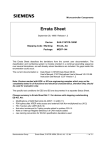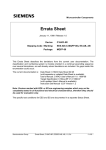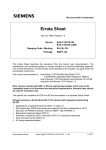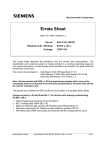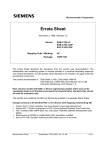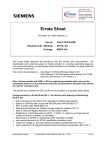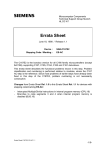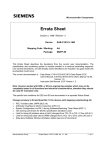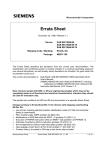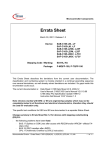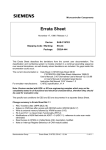Download Errata Sheet
Transcript
Microcontroller Components Errata Sheet September 28, 1998 / Release 1.3 Device: SAK-C167CR-LM Stepping Code / Marking: ES-BE, BE Package: MQFP-144 This Errata Sheet describes the deviations from the current user documentation. The classification and numbering system is module oriented in a continual ascending sequence over several derivatives, as well already solved deviations are included. So gaps inside this enumeration could occur. The current documentation is: Data Sheet: C167CR Data Sheet 06.95, User’s Manual: C167 Derivatives User’s Manual V2.0 03.96 Instruction Set Manual 12.97 Version 1.2 Note: Devices marked with EES- or ES are engineering samples which may not be completely tested in all functional and electrical characteristics, therefore they should be used for evaluation only. The specific test conditions for EES and ES are documented in a separate Status Sheet. Change summary to Errata Sheet Rel.1.2 for devices with stepping code/marking ES-BE, BE: • • • • • Modifications of ADM field while bit ADST = 0 (ADC.11) P0H spikes after XPER write access and external 8-bit Non-multiplexed bus (X12) PEC Transfers after JMPR (BUS.18) Note on Interrupt Register Behaviour of CAN module added new naming convention for DC/AC specification deviations used Semiconductor Group Errata Sheet, C167CR-LM, ES-BE, BE, 1.3, Mh - 1 of 11 - Functional Problems: ADC.10: Start of Standard Conversion at End of Injected Conversion When an A/D conversion in any of the standard modes (single channel, auto scan, continuous modes) is started by software within a time window of 2 TCL (50 ns @ 20 MHz) before the end of an injected conversion, the following problem will occur: - the result of the injected conversion is not transferred to ADDAT2, and interrupt request flag ADEIR is not set - no further requests for injected conversions are processed - the standard conversion is not started (i.e. the A/D converter is blocked) Workaround 1: When using the continuous conversion modes, enable channel injection after conversion in the continuous mode has been started. Workaround 2: Do not start a standard conversion while an injected conversion is in progress. In this case, start the standard conversion in the ADEINT interrupt service routine which is invoked after the injected conversion is finished. As an indication whether an injected conversion is in progress, bits ADCRQ or ADBSY may be tested. - Main Program: ... ATOMIC #3 ; see Note 1) BMOV ADStart, ADCRQ ; copy current status of ADCRQ JB ADStart, Done ; injected conversion in progress ? BSET ADST ; no: start standard conversion here, ; see Note 2) Done: ... ; yes: start standard conversion in ADEINT ISR - ADEINT Interrupt Service Routine: ... EXTR #1 MOV ICResult, ADDAT2 JNB ADStart, Done2 ATOMIC #2 JB ADCRQ, Done2 BSET ADST BCLR ADStart Done2: ... RETI ; read ADDAT2 to avoid wait-for-read situation ; start of standard conversion required ? ; yes, see Note 1) ; - another injected conversion in progress ? ; if yes: start standard conversion in next ; invocation of ADEINT ISR, see Note 3) ; no other injected conversion in progress: ; start standard conversion here, see Note 2) ; clear flag Note 1): ATOMIC should be used here to ensure correct flag handling and avoid side effects which may be caused by interrupts Note 2): In case ADCRQ has been set by a channel injection request from CC31 in the time between the second half of the decode phase and the second half of the execute phase of instruction BSET ADST, flag ADCRQ may be unintentionally cleared by instruction BCLR ADST due to missing hardware bit protection of bit ADCRQ. This does not effect the actual start and processing of an injected conversion, since an internal (not user accessible) latch controls its correct operation. However, bit ADCRQ does not reflect the correct status for this particular injected conversion. Semiconductor Group Errata Sheet, C167CR-LM, ES-BE, BE, 1.3, Mh - 2 of 11 - Note 3): This extra test of ADCRQ may be omitted if it can be guaranteed that the processing of the ADEINT interrupt service routine which was triggered by the last injected conversion is not delayed that long by higher priority tasks that already the next injected conversion is finished when the standard conversion shall be started in the ADEINT routine. Compatibility with previous steps of the C167CR In previous steps (e.g. C167CR-LM AB-step), an injected conversion in progress was aborted when a standard conversion was started by software (see C167 User’s Manual V1.0 or V2.0, p. 16-8, third Note). If this effect was not desired, it was suggested to check whether no injected conversion was in progress before starting a standard conversion. This means that all systems which have considered this proposal implicitly already have implemented the workaround described above and will work without problems also with the C167CR-LM BE-step. In the C167CR-LM BE-step, as a correction of problem ADC.7 (Channel Injection request coincident with start of standard conversion), start of standard conversions will no longer abort injected conversions. If this ’new’ feature is used, the above software workaround must be used. If the abortion of an injected conversion by the start of a standard conversion was tolerated in sytems with previous steps (e.g. C167CR-LM AB-step), the workaround must be implemented when switching to the C167CR-LM BE-step. ADC.11: Modifications of ADM field while bit ADST = 0 The A/D converter may unintentionally start one auto scan single conversion sequence when the following sequence of conditions is true: (1) the A/D converter has finished a fixed channel single conversion of an analog channel n > 0 (i.e. contents of ADCON.ADCH = n during this conversion) (2) the A/D converter is idle (i.e. ADBSY = 0) (3) then the conversion mode in the ADC Mode Selection field ADM is changed to Auto Scan Single (ADM = 10b) or Continuous (ADM = 11b) mode without setting bit ADST = 1 with the same instruction Under these conditions, the A/D converter will unintentionally start one auto scan single conversion sequence, beginning with channel n-1, down to channel number 0. In case the channel number ADCH has been changed before or with the same instruction which selected the auto scan mode, this channel number has no effect on the unintended auto scan sequence (i.e. it is not used in this auto scan sequence). Note: When a conversion is already in progress, and then the configuration in register ADCON is changed, - the new conversion mode in ADM is evaluated after the current conversion - the new channel number in ADCH and new status of bit ADST are evaluated after the current conversion when a conversion in fixed channel conversion mode is in progress, and after the current conversion sequence (i.e. after conversion of channel 0) when a conversion in an auto scan mode is in progress. In this case, it is a specified operational behaviour that channels n-1 .. 0 are converted when ADM is changed to an auto scan mode while a fixed channel conversion of channel n is in progress (see e.g. C167 User’s Manual, V2.0, p16-4) Workaround: When an auto scan conversion is to be performed, always start the A/D converter with the same instruction which sets the configuration in register ADCON. Semiconductor Group Errata Sheet, C167CR-LM, ES-BE, BE, 1.3, Mh - 3 of 11 - PWRDN.1: Execution of PWRDN Instruction while pin NMI# = high When instruction PWRDN is executed while pin NMI# is at a high level, power down mode should not be entered, and the PWRDN instruction should be ignored. However, under the conditions described below, the PWRDN instruction may not be ignored, and no further instructions are fetched from external memory, i.e. the CPU is in a quasi-idle state. This problem will only occur in the following situations: a) the instructions following the PWRDN instruction are located in external memory, and a multiplexed bus configuration with memory tristate waitstate (bit MTTCx = 0) is used, or b) the instruction preceeding the PWRDN instruction writes to external memory or an XPeripheral (XRAM, CAN), and the instructions following the PWRDN instruction are located in external memory. In this case, the problem will occur for any bus configuration. Note: the on-chip peripherals are still working correctly, in particular the Watchdog Timer will reset the device upon an overflow. Interrupts and PEC transfers, however, can not be processed. In case NMI# is asserted low while the device is in this quasi-idle state, power down mode is entered. Workaround: Ensure that no instruction which writes to external memory or an XPeripheral preceeds the PWRDN instruction, otherwise insert e.g. a NOP instruction in front of PWRDN. When a muliplexed bus with memory tristate waitstate is used, the PWRDN instruction should be executed out of internal RAM or XRAM. CPU.9: PEC Transfers during instruction execution from Internal RAM When a PEC transfer occurs after a jump with cache hit during instruction execution from internal RAM (locations 0F600h - 0FDFFh), the instruction following the jump target instruction may not be (correctly) executed. This problem occurs when the following sequence of conditions is true: i) a loop terminated with a jump which can load the jump target cache (possible for JMPR, JMPA, JB, JNB, JBC, JNBS) is executed in the internal RAM ii) at least two loop iterations are performed, and no JMPS, CALLS, RETS, TRAP, RETI instruction or interrupt is processed between the last and the current iteration through the loop (i.e. the condition for a jump cache hit is true) iii) a PEC transfer is performed after the jump at the end of the loop has been executed iv) the jump target instruction is a double word instruction Note: No problem will occur during instruction execution from the internal XRAM (locations 0E000h 0E7FFh). Workaround 1: Place a single word instruction (e.g. NOP) at the jump target address in the internal RAM. Workaround 2: Use JMPS (unconditional) or JMPI (conditional) instructions at the end of the loop in the internal RAM. These instructions will not use the jump cache. Semiconductor Group Errata Sheet, C167CR-LM, ES-BE, BE, 1.3, Mh - 4 of 11 - CPU.17: Arithmetic Overflow by DIVLU instruction For specific combinations of the values of the dividend (MDH,MDL) and divisor (Rn), the Overflow (V) flag in the PSW may not be set for unsigned divide operations, although an overflow occured. E.g.: MDH F0F0 MDL Rn MDH MDL 0F0Fh : F0F0h = FFFF FFFFh, but no Overflow indicated ! (result with 32-bit precision: 1 0000h) The same malfunction appears for the following combinations: n0n0 0n0n : n0n0 n00n 0nn0 : n00n n000 000n : n000 n0nn 0nnn : n0nn where n means any Hex Digit between 8 ... F i.e. all operand combinations where at least the most significat bit of the dividend (MDH) and the divisor (Rn) is set. In the cases where an overflow occurred after DIVLU, but the V flag is not set, the result in MDL is equal to FFFFh. Workaround: Skip execution of DIVLU in case an overflow would occur, and explicitly set V = 1. E.g.: CMP Rn, MDH JMPR cc_ugt, NoOverflow ; no overflow if Rn > MDH BSET V ; set V = 1 if overflow would occur JMPR cc_uc, NoDivide ; and skip DIVLU NoOverflow: DIVLU Rn NoDivide: ... ; next instruction, may evaluate correct V flag Note: - the KEIL C compiler, run time libraries and operating system RTX166 do not generate or use instruction sequences where the V flag in the PSW is tested after a DIVLU instruction. - with the TASKING C166 compiler, for the following intrinsic functions code is generated which uses the overflow flag for minimizing or maximizing the function result after a division with a DIVLU: _div_u32u16_u16() _div_s32u16_s16() _div_s32u16_s32() Consequently, an incorrect overflow flag (when clear instead of set) might affect the result of one of the above intrinsic functions but only in a situation where no correct result could be calculated anyway. These intrinsics first appeared in version 5.1r1 of the toolchain. Libraries: not affected Semiconductor Group Errata Sheet, C167CR-LM, ES-BE, BE, 1.3, Mh - 5 of 11 - BUS.18: PEC Transfers after JMPR instruction Problems may occur when a PEC transfer immediately follows a taken JMPR instruction when the following sequence of 4 conditiions is met (labels refer to following examples): 1. in an instruction sequence which represents a loop, a jump instruction (Label_B) which is capable of loading the jump cache (JMPR, JMPA, JB/JNB/JBC/JNBS) is taken 2. the target of this jump instruction directly is a JMPR instruction (Label_C) which is also taken and whose target is at address A (Label_A) 3. a PEC transfer occurs immediately after this JMPR instruction (Label_C) 4. in the following program flow, the JMPR instruction (Label_C) is taken a second time, and no other JMPR, JMPA, JB/JNB/JBC/JNBS or instruction which has branched to a different code segment (JMPS/CALLS) or interrupt has been processed in the meantime (i.e. the condition for a jump cache hit for the JMPR instruction (Label_C) is true) In this case, when the JMPR instruction (Label_C) is taken for the second time (as described in condition 4 above), and the 2 words stored in the jump cache (word address A and A+2) have been processed, the word at address A+2 is erroneously fetched and executed instead of the word at address A+4. Note: the problem does not occur when the jump instruction (Label_C) is a JMPA instruction Example1: Label_A: instruction x ; Begin of Loop instruction x+1 ..... Label_B: JMP Label_C ; JMP may be any of the following jump instructions: JMPR cc_zz, JMPA cc_zz, JB/JNB/JBC/JNBS ; jump must be taken in loop iteration n ; jump must not be taken in loop iteration n+1 ..... Label_C: JMPR cc_xx, Label_A ; End of Loop ; instruction must be JMPR (single word instruction) ; jump must be taken in loop iteration n and n+1 ; PEC transfer must occur in loop iteration n Example2: Label_A: instruction x ; Begin of Loop1 instruction x+1 ..... Label_C: JMPR cc_xx, Label_A ; End of Loop1, Begin of Loop2 ; instruction must be JMPR (single word instruction) ; jump not taken in loop iteration n-1, i.e. Loop2 is entered ; jump must be taken in loop iteration n and n+1 ; PEC transfer must occur in loop iteration n ..... Label_B: JMP Label_C ; End of Loop2 ; JMP may be any of the following jump instructions: JMPR cc_zz, JMPA cc_zz, JB/JNB/JBC/JNBS ; jump taken in loop iteration n-1 A code sequence with the basic structure of Example1 was generated e.g. by a compiler for comparison of double words (long variables). Semiconductor Group Errata Sheet, C167CR-LM, ES-BE, BE, 1.3, Mh - 6 of 11 - Workarounds: 1. use a JMPA instruction instead of a JMPR instruction when this instruction can be the direct target of a preceeding JMPR, JMPA, JB/JNB/JBC/JNBS instruction, or 2. insert another instruction (e.g. NOP) as branch target when a JMPR instruction would be the direct target of a preceeding JMPR, JMPA, JB/JNB/JBC/JNBS instruction, or 3. change the loop structure such that instead of jumping from Label_B to Label_C and then to Label_A, the jump from Label_B directly goes to Label_A. Notes on compilers: In the Hightec compiler beginning with version Gcc 2.7.2.1 for SAB C16x – V3.1 Rel. 1.1, patchlevel 5, a switch –m bus18 is implemented as workaround for this problem. In addition, optimization has to be set at least to level 1 with –u1. The Keil C compiler and run time libraries do not generate or use instruction sequences where a JMPR instruction can be the target of another jump instruction, i.e. the conditions for this problem do not occur. Other compilers under evaluation. RST.1: System Configuration via P0L.0 during Software/Watchdog Timer Reset Unlike P0L.5 .. P0L.1, P0L.0 is not disregarded during software or watchdog timer reset. This means that when P0L.0 is (erroneously) externally pulled low at the end of the internal software or watchdog timer reset sequence, the device will enter emulation mode. Therefore, ensure that the level at P0L.0 is above the minimum input high voltage VIHmin= 0.2 Vcc + 0.9 V (1.9 V @ Vcc = 5.0 V) at the end of the internal reset sequence. X9: Read Access to XPERs in Visible Mode The data of a read access to an XBUS-Peripheral (XRAM, CAN) in Visible Mode is not driven to the external bus. PORT0 is tristated during such read accesses. Semiconductor Group Errata Sheet, C167CR-LM, ES-BE, BE, 1.3, Mh - 7 of 11 - X12: P0H spikes after XPER write access and external 8-bit Non-multiplexed bus When an external 8-bit non-multiplexed bus mode is selected and P0H is used for general purpose I/O, and an internal (byte or word) write access to an XBUS peripheral (e.g. XRAM, CAN, or I²C module) is performed, and an external bus cycle is directly following the internal XBUS write cycle, then P0H is actively driven with the write data for approx. 7ns (spikes on P0H). The spikes also occur if P0H is configured as input. However, read operations from P0H are not affected and will always return the correct logical state. The spikes have the following position and shape in a typical application: spikes occur after the rising edge of CLKOUT which follows the rising edge of ALE for the external bus cycle P0H.x = low --> output low voltage rises to approx. 2.5V, spike width approx. 7ns (@ 0.2 Vcc) P0H.x = high --> output high voltage drops to approx. 2.0V, spike width approx. 7ns (@ 0.8 Vcc) Referring to a worst case simulation the maximum width of the spikes may be 15ns with full amplitude (Vcc/Vss). But this might not be seen on application level. Note that if any of the other bus modes is selected in addition to the 8-bit non-multiplexed mode, P0H can not be used for I/O per default. Workaround: - use a different port instead of P0H for I/O when (only) an external 8-bit non-multiplexed bus mode is selected or use a different bus type (e.g. 8-bit multiplexed, where P1H may be used for I/O instead of P0H) or the spikes on P0H may be filtered with an application specific RC element, or do not perform an external bus access directly after an XBUS write access: this may be achieved by an instruction sequence which is executed in internal ROM/Flash/OTP, or internal RAM, or internal XRAM e.g. ATOMIC #3 ; to prevent PEC transfers which may access external memory instruction which writes to XBUS peripheral NOP NOP Note on Interrupt Register behaviour of the CAN module Due to the internal state machine of the CAN module, a specific delay has to be considered between resetting INTPND and reading the updated value of INTID. See Application Note AP2924 " Interrupt Register behaviour of the CAN module in Siemens 16-bit Microcontrollers" on http://www.siemens.de/semiconductor/products/ics/34/pdf/ap292401.pdf Semiconductor Group Errata Sheet, C167CR-LM, ES-BE, BE, 1.3, Mh - 8 of 11 - Deviations from Electrical- and Timing Specification: The following table lists the deviations of the DC/AC characteristics from the specification in the C167CR Data Sheet 6.95. Problem Parameter short name Symbol Max. CPU Clock = 20 MHz min. max. Variable CPU Clock Unit 1/2TCL = 1 to 20 MHz min. max. AC.t15.1 RD# to valid data in (no RW-delay) t15 - 50+tc instead of 55+tc 3TCL-25+tc ns instead of 3TCL -20+tc AC.t16.1 ALE low to valid data t16 in - 50+tc instead of 55+tc 3TCL-25+tc ns instead of 3TCL -20+tc AC.t34.1 CLKOUT rising edge t34 to ALE falling edge 0+ta 12+ta 0+ta instead of 10+ta 12+ta instead of 10+ta ns AC.t38.2 ALE falling edge to CS# -10-ta 10-ta instead of 5-ta 10-ta ns t38 -10-ta instead of -5-ta Notes: 1) Pin READY# has an internal pullup (all C167xx derivatives). This will be documented in the next revision of the Data Sheet. 2) Timing t28: Parameter description and test changed from ’Address hold after RD#/WR#’ to ’Address hold after WR#’. It is guaranteed by design that read data are internally latched by the controller before the address changes. 3) During reset, the internal pullups on P6.[4:0] are active, independent whether the respective pins are used for CS# function after reset or not. Semiconductor Group Errata Sheet, C167CR-LM, ES-BE, BE, 1.3, Mh - 9 of 11 - History List (since device step BA) Functional Problems Functional Short Description Problem Fixed in step ADC.7 Channel Injection coincident with start of standard conversion BA ADC.8 CC31/ADC Interference BE ADC.10 Start of Standard Conversion at End of Injected Conversion ADC.11 Modifications of ADM field while bit ADST = 0 CAPCOM.1 Software Update of CAPCOM Timers BA CPU.7 Warm hardware reset (pulse length < 1032 TCL) BA CPU.10 Bit Protection for register TFR BA BUS.18 PEC transfers after JMPR CPU.9 PEC Transfers during instruction execution from Internal RAM CPU.17 Arithmetic Overflow by DIVLU instruction PWRDN.1 Execution of PWRDN Instruction while pin NMI# = high RST.1 System Configuration via P0L.0 during Software/Watchdog Timer Reset XRAM.1 XRAM Access in XPER-SHARE Mode X9 Read Access to XPERs in Visible Mode X10 P0H I/O conflict during XPER access and external 8-bit Non-multiplexed bus X12 P0H spikes after XPER write access and external 8-bit Non-multiplexed bus BA BE AC/DC Deviations AC/DC Deviation Short Description AC.t15.1 RD# to valid data in 3TCL-25ns AC.t16.1 ALE low to valid data in 3TCL-25ns AC.t34.1 CLKOUT rising edge to ALE falling edge 12ns AC.t38.2 ALE falling edge to CS# -10ns Semiconductor Group Errata Sheet, C167CR-LM, ES-BE, BE, 1.3, Mh Fixed in step - 10 of 11 - In addition to the decription in the C167 Derivatives User’s Manual V2.0, the following feature enhancement has been implemented in the C167CR-LM BE-step: Incremental position sensor interface For each of the timers T2, T3, T4 of the GPT1 unit, an additional operating mode has been implemented which allows to interface to incremental position sensors (A, B, Top0). This mode is selected for a timer Tx via TxM = 110b in register TxCON, x = (2, 3, 4). Optionally, the contents of T5 may be captured into register CAPREL upon an event on T3. This feature is selected via bit CT3 = 1 in register T5CON.10 Compatibility with previous versions: In previous versions (e.g. C167CR-LM BA-step), both of the settings (TxM = 110b, T5CON.10 = 1) were reserved and should not be used. Therefore, systems designed for previous versions will also work without problems with the C167CR-LM BE-step. Application Support Group, Munich Semiconductor Group Errata Sheet, C167CR-LM, ES-BE, BE, 1.3, Mh - 11 of 11 -











